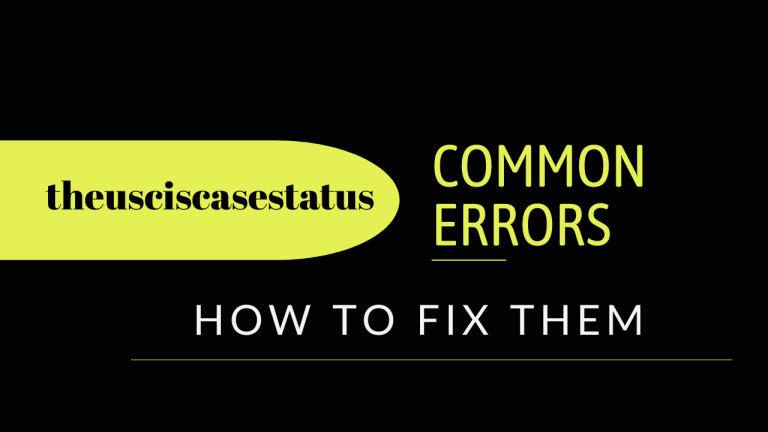When you’re applying for immigration benefits like a visa, green card, or U.S. citizenship, one of the most important things to keep track of is your USCIS case status. The United States Citizenship and Immigration Services (USCIS) is the government agency responsible for processing these applications, and understanding your case status helps you stay informed about the progress of your application.
In this guide, we’ll explain how to check your USCIS case status, what different status updates mean, and how to stay on top of the process. Whether you’re waiting for a green card, a work permit, or citizenship, knowing where your case stands can help reduce stress and ensure you’re prepared for the next steps.
USCIS Case Status: Understanding Key Updates and Terms
What is USCIS Case Status?
USCIS case status is the current status or stage of your application with USCIS. Every time your application goes through a review process or step, USCIS updates your case status to reflect its progress. This could be a change in the status, such as when your application is approved, denied, or under review.
The status update will tell you whether your application is still in process, if additional information is needed, or if a decision has been made. Checking your USCIS case status regularly is a good way to stay on top of the process.
Why is It Important to Track Your USCIS Case Status?
Tracking your USCIS case status is essential for a few key reasons:
- Stay Informed: By knowing the status of your case, you can stay informed about any changes or updates.
- Know What to Expect: Understanding your case status helps you know what to expect next in the process, whether it’s an approval, request for more documents, or an interview.
- Act Quickly When Necessary: If there’s an issue with your case or if USCIS requests more documents, tracking your status will allow you to respond quickly and avoid delays.
How to Check Your USCIS Case Status
The easiest way to check your USCIS case status is online. Here’s how to do it:
- Find Your Receipt Number: When you submit your application to USCIS, they will send you a notice (Form I-797) that includes your receipt number. This is a unique number that identifies your case.
- Visit the USCIS Case Status Page: Go to the official USCIS website, and you will find a section where you can check your case status online.
- Enter Your Receipt Number: On the website, you’ll be asked to enter your receipt number. It’s important to enter it exactly as it appears on your notice.
- Click ‘Check Status’: After entering the number, click the “Check Status” button to see the latest update for your case.
Common USCIS Case Status Updates
There are several status updates you might encounter when checking your USCIS case. Below are the most common ones:
a) Case Was Received
This status means USCIS has received your application and is starting the processing. It’s the first status you’ll see after submitting your application.
- What it means: USCIS has your application and is beginning to review it. You don’t need to take any action unless USCIS asks for additional documents.
b) Case Is Under Review
If your case status says “Case is under review,” it means USCIS is currently reviewing the details of your application. This could involve checking your documents, verifying information, or conducting background checks.
- What it means: Your case is being processed. This step can take some time depending on the type of application you’ve submitted.
c) Request for Evidence (RFE)
An RFE means USCIS needs more information or documents to process your application. They will send you a notice explaining exactly what’s missing.
- What it means: You need to respond to the RFE within the given deadline. If you don’t, it could delay the process or result in denial.
d) Case Approved
When your case status says “Case Approved,” it means USCIS has reviewed your application and approved it. This could mean that your visa, green card, or citizenship application is successful.
- What it means: Your application has been approved, and USCIS will send you a decision notice or instructions on the next steps, like issuing a green card or visa.
e) Case Denied
If your status says “Case Denied,” USCIS has decided not to approve your application. The notice will explain the reason for the denial, and you may be able to appeal the decision or reapply.
- What it means: If your case is denied, you can read the denial notice and see if there are options to appeal or correct any mistakes before reapplying.
f) Notice of Intent to Deny (NOID)
A NOID means that USCIS is considering denying your case because something in your application doesn’t meet their requirements. You typically have a chance to respond before the denial is final.
- What it means: If you receive a NOID, take immediate action. Respond by providing the required information or documentation to prevent your case from being denied.
g) Case Transferred
If your case status says it’s been transferred, it means your application has been moved from one USCIS office to another.
- What it means: This doesn’t mean anything bad; it’s just a part of the process. USCIS will continue processing your case, though it may take a little longer because of the transfer.
h) Interview Scheduled
If your case status shows that an interview has been scheduled, it means that USCIS wants to meet with you in person as part of the review process.
- What it means: Be prepared for your interview. Bring all the required documents and information, and attend on the scheduled date.
What to Do If Your USCIS Case Status Is Not Updating
Sometimes, your USCIS case status might not change for a while, or it may seem stuck at one status. Here are some possible reasons why this could happen and what you can do:
a) Processing Delays
USCIS can sometimes have a backlog of cases, especially during peak times, which can delay the update of your case status.
- What to do: Be patient and check your status periodically. Processing times can vary, so check USCIS’s website for average times for your type of case.
b) Request for Evidence
If you haven’t received an RFE yet, but your case status is stuck, USCIS may need more information from you.
- What to do: If you think an RFE might be coming, check the mail regularly for any requests.
c) Technical Issues
Occasionally, USCIS may experience technical issues with their system, causing delays in updating case statuses online.
- What to do: If your case status hasn’t updated for a long time, contact USCIS customer service to check if there are any technical issues or delays.
What to Do If Your USCIS Case Status Shows an Issue
If your case status shows something unexpected, like a denial or a request for evidence, it’s important to act quickly. Here’s what you can do:
- Case Denied: Review the denial notice carefully. You may be able to appeal or correct any issues with your application before reapplying.
- Request for Evidence (RFE): If you receive an RFE, respond as quickly as possible with the requested documents or information. Missing the deadline can delay or hurt your case.
- Notice of Intent to Deny (NOID): If you receive a NOID, respond with the necessary information or clarification to prevent denial.
Conclusion
Tracking your USCIS case status is an essential part of the immigration process. By understanding the different case status updates, you can stay informed about your application’s progress and take action when necessary. Whether you’re waiting for approval, attending an interview, or responding to an RFE, knowing where your case stands can reduce stress and help you make the right decisions.
Remember, USCIS processes applications carefully, and delays are common. Be patient, stay proactive, and always check your case status regularly to keep things moving smoothly.



